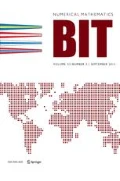Introduction to the contents of issue 52:4
The issue you now have in your hand, or on your screen, shows that BIT is becoming successively more present in the Scientific Computation area. We have three papers that deal with computational solution of magnetohydrodynamical, MHD, problems, and two more contributions of a computational physics flavor.
In the first paper, Lyonell Boulton and Michael Strauss derive certified enclosures for eigenvalues of linear MHD operators, in the practically interesting plane slab and cylindrical pinch configurations. Schur complements are needed for the computation. The position of the essential spectrum makes this more complicated than finding eigenvalue bounds for matrix problems.
A related problem is treated in the paper by Paolo Corti and Siddhartha Mishra who study algorithms for the magnetic induction equations with Hall Effect. These equations are non-linear and include third-order spatial and spatio-temporal mixed derivatives. They develop stable finite difference schemes that preserve the energy bounds for the continuous problem.
In the third MHD related paper, Holger Heumann, Ralf Hiptmair, Kun Li, and Jinchao Xu study fully discrete semi-Lagrangian methods for advection dominated differential forms. These occur as building blocks for MHD models.
In another physics paper, Haotao Cai develops a fast solution algorithm for the Dirichlet problem of the Helmholtz equation in two dimensions, by solving a boundary integral equation of the first kind. It gives a sparse matrix and the cost of its solution grows with a linear bound when a Fourier Galerkin algorithm is used.
In the final physics paper, David Cohen and Ludwig Gauckler solve the cubic time dependent Schrödinger equation with spectral discretization in space and an exponential integrator in time. They show how to keep energy, mass and momentum constant along the numerical solution over long times.
We have three contributions in this issue to Numerical Linear Algebra:
Zvonimir Bujanović and Zlatko Drmač study a block two sided Jacobi, or more properly Kogbetliantz, method for computing the singular value decomposition, SVD, of a matrix. Global convergence and asymptotic quadratic convergence is established, which makes a parallel implementation feasible.
Cedric Effenberger and Daniel Kressner develop an algorithm for an eigenvalue problem that is nonlinear in the eigenvalue parameter. They approximate the nonlinear function with a Chebyshev interpolation polynomial, whose eigenvalue problem can be solved by the usual Krylov subspace methods.
Miroslav Rozložník, Miroslav Tůma, Alicja Smoktunowicz, and Jiří Kopal study the numerical stability of orthogonalization methods where the inner product is induced by a nontrivial symmetric positive definite matrix. Errors caused by finite precision arithmetic in the orthogonalization and reorthogonalization are analyzed.
We have two contributions in Numerical Approximation related to computer aided geometric design, CAGD:
Xuli Han and Yuanpeng Zhu describe Bezier curves based on trigonometric functions. Such curves may be better than the standard polynomials, when adjusting shape and fitting to control points.
Marie-Laurence Mazure gives a new criterion to decide whether a spline space is useful for CAGD. She studies splines with pieces taken from different Extended Chebyshev spaces, that satisfy parametric continuity conditions at the knots.
Finally we have one paper that deals with the inner work of a computational algorithm:
Siegfried M. Rump studies a consistent set of rules for interval arithmetic with finitely many endpoints. The end points are taken from the finite set of representable numbers, in e.g. an IEEE 754 system, but intervals may have either open or closed ends, which allows handling of converging sequences with a limit.
Editorial board
We thank Per Christian Hansen who leaves the board after ten years service. He has given BIT presence in his image processing specialty and on the Danish scene, concluded with the nice BIT Circus last summer in Copenhagen.
We welcome three new board members, Rosemary Renaut from Arizona State University, Raul Tempone, King Abdullah University of Science and Technology, Saudi Arabia, previously at KTH in Stockholm, and Michael Vogelius, Rutgers University, New Jersey, USA. We already know you as members of the BIT family, now we look forward to your help to make BIT present in your specialties and in your circles!
Referees
Let me end this, my tenth year as your Editor in Chief, by saying thank you to all referees that have helped BIT and the authors to keep our quality. You are anonymous to the authors but we acknowledge your fundamental help to BIT.
These are present in the BIT files this year. Forgive me, if I have lost somebody deserving to be on this list:


Thank you all for this year and see you later for BIT!

Axel Ruhe
Author information
Authors and Affiliations
Corresponding author
Rights and permissions
About this article
Cite this article
Ruhe, A. Editorial. Bit Numer Math 52, 797–800 (2012). https://doi.org/10.1007/s10543-012-0408-y
Published:
Issue Date:
DOI: https://doi.org/10.1007/s10543-012-0408-y

